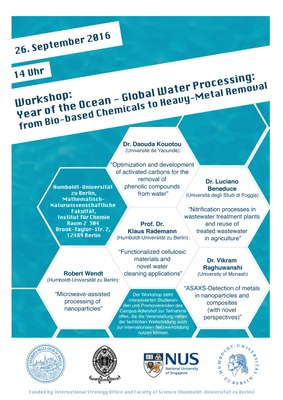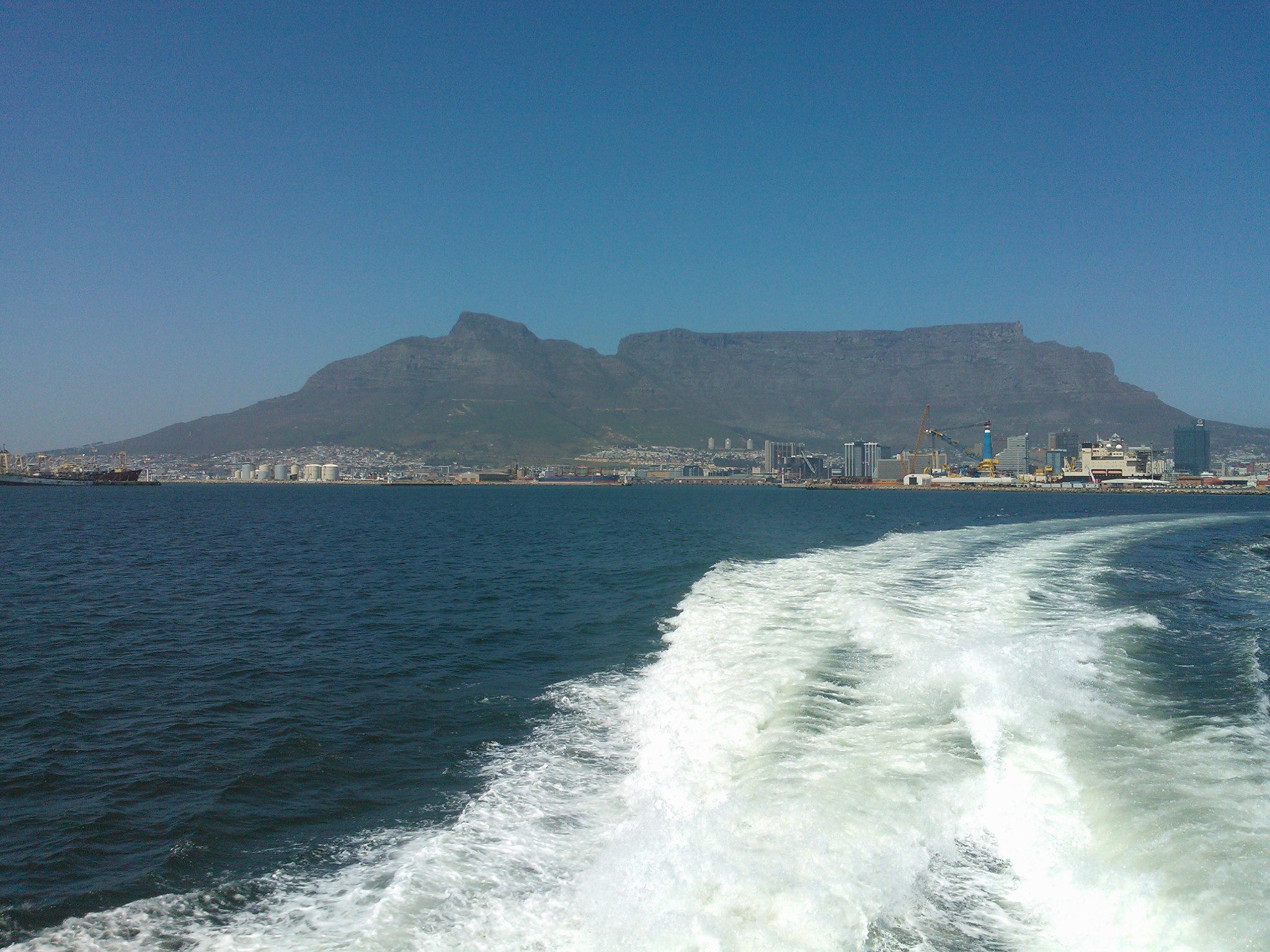1st Workshop: Year of the Ocean - Global Water Processing: from Bio-based Chemicals to Heavy-Metal Removal
 26.09.2016
26.09.2016
Start: 2 pm
Presentations:
Dr. Luciano Beneduce (Università degli Studi di Foggia, Italien)
"Nitrification processes in wastewater treatment plants and reuse of treated wastewater in agriculture"
Dr. Vikram Raghuwanshi (Monash University, Australien)
"ASAXS-Detection of metals in nanoparticles and composites (with novel perspectives)"
M. Sc. Uthpala Garusinghe (Monash University, Australien)
"Nanocellulose-nanoparticle composites and their applications"
Dipl.-Chem. Robert Wendt (Humboldt-Universität zu Berlin)
"Microwave-assisted processing of nanoparticles: nucleation, growth, characterization and applications"
Prof. Dr. Klaus Rademann (Humboldt-Universität zu Berlin)
"Functionalized cellulosic materials and novel water cleaning applications"
Record of the Workshop: Year of the Ocean – Global Water Processing Research Potentials:
from Cellulose based research to Bio-based Chemicals for toxic Heavy-Metal and Dye Removal

(l.t.r. Robert Wendt, Klaus Rademann, Luciano Beneduce, Uthpala Garusinghe, Vikram Raghuwanshi, Julius Stückrath, Kevin Schiefelbein)


(Kim Greis, Klaus Rademann)
On 26th of September 2016 the workshop Year of the Ocean – Global Water Processing Research Potentials: from Cellulose based research to Bio-based Chemicals for toxic Heavy-Metal and Dye Removal was organised at the Institute of Chemistry, combining scientists of the Monash University (Australia), Università degli studi di Foggia (Italy) and Humboldt-Universität zu Berlin (Germany).
The international researchers presented their work on the highly important topic of worldwide water pollution.
The workshop was attended by professors, postdocs, PhD students and bachelor students. Furthermore, the origin of different disciplines of the guests (chemistry, microbiology, physics and chemical engineering) showed how interdisciplinary the concern of future water cleaning and processing really is.
The workshop started with a presentation of the host, Prof. Dr. Klaus Rademann, who introduced the highly actual topic ‘Functionalized cellulosic materials for novel water cleaning applications’. He welcomed the guests and started by presenting the state-of-the-art and actual situation of global water contamination by dyes, heavy-metals, nitrates and nitrites. Even in so-called developed countries, like Germany, the drinking water is sometimes contaminated with heavy-metals and nitrates.
A second presentation was given by Prof. Dr. Luciano Beneduce, a microbiologist from Università degli Studi di Foggia, Italy. The subject of his presentation was ‘Nitrification processes in wastewater treatment plants and reuse of treated wastewater in agriculture’. He provided insights into different methods of removing ammonia and nitrates from wastewater, using diverse bacteria which are able to oxidize ammonia and to reduce nitrates. Moreover, data was shown which suggested that cleaned wastewater could be reused in agriculture.
The third presentation was held by Dr. Vikram Raghuwanshi, a postdoctoral research fellow from the Monash University in Melbourne, Australia. He is a 2016 Humboldt-Talent-Travel-Awardee. The topic of his presentation was ‘ASAXS-Detection of metals in nanoparticles and composites with novel perspectives’. The talk explained the synthesis and the size detection of nanoparticles using small angle X-ray scattering. Nanoparticles may be used for removing heavy-metals from contaminated water.
Robert Wendt (Humboldt-Universität zu Berlin) was the presenter of the fourth session. His topic ‘Microwave-assisted processing of nanoparticles’ inspired the audience to discuss new research approaches in the realm of the synthesis of nanoparticles using microwaves. Especially the use of iron oxide nanoparticles is not only fascinating from a fundamental point of view, but also because they may be used in waste water treatment and biomedicine. Furthermore, magnetic iron oxide and titania hybrid nanoparticles are used for the degradation of methylene blue and other toxic dyes.
The last presentation was held by Ms. Uthpala Garusinghe (B.Sc. in Chemical Engineering, Monash University, Australia), concerning ‘Nanocellulose nanoparticle composites and their applications’. Her research aims at developing novel composites for packaging materials that may also be used for water purification. The materials that she synthesised are as good as common plastic materials but they are biodegradable and recyclable.
This workshop, which is also a starting point for a bigger research project on water cleaning processes in collaboration with the National University of Singapore, shall be followed by a second sequence this December. Then a specialist for water purification, Dr. Daouda Kouotou from Université de Yaoundé (Cameroon), will visit the department.
The workshop was a big success and will be continued in 2017. Further results will be published and made available to the public through open-access journals.
Kim Greis
Funded by:
Faculty of Science & International Strategy Office, Humboldt Universität zu Berlin
